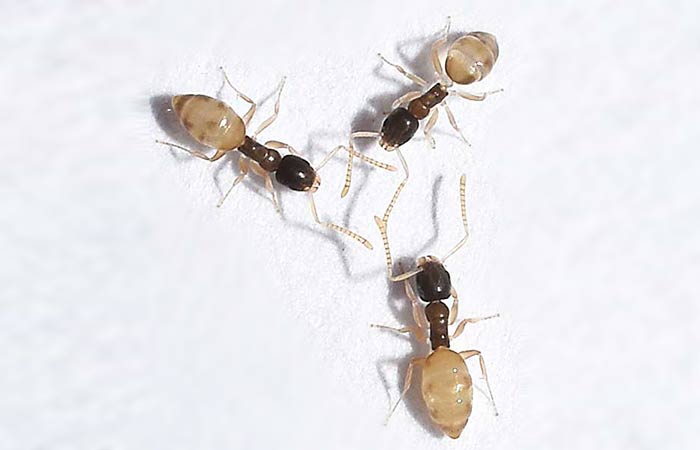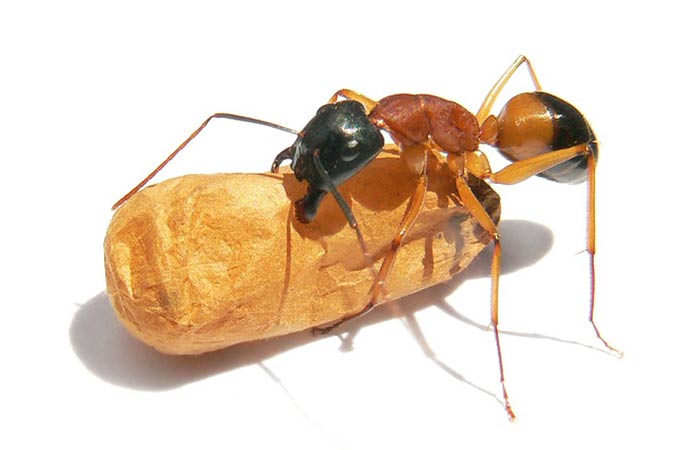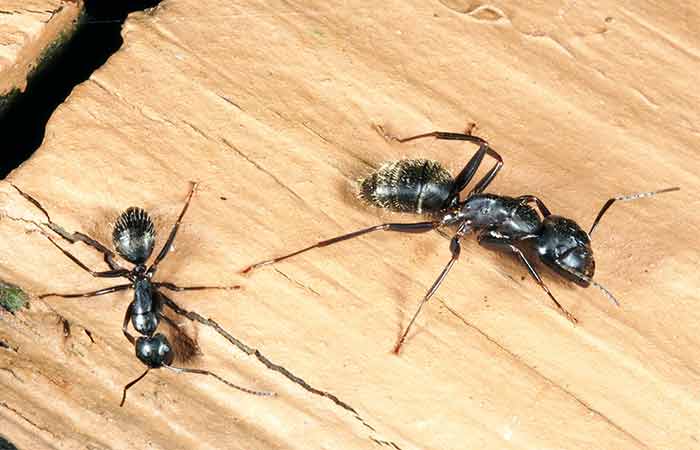Ants in Bathroom-Why, How to Get Rid & Prevent
Ants are tiny blackish or brown insects that get into the bathroom due to the moist and warm environment which attracts them. To get rid of ants in your bathroom, you can use vinegar, castile soap spray and even insecticides such as Diatomaceous Earth. Read on to get more details on the matter.
Why are there Ants in my Bathroom?
A bathroom is an attractive place for ants, since they enjoy moist and dark spaces. The scent of perfumes, bath salts, soaps, lotions, and toothpaste in your bathroom, combined with clogged drains and water puddles, is an excellent base for a permanent ant infestation.
What are the Tiny Ants in the Bathroom?
Ghost Ants
These types of ants are minuscule. Their size ranges between 1.3 to 1.5 mm. The top half of ghost ants tends to be dark brown, with the bottom half appearing to be opaque of white or yellow.
These white creatures appear and disappear in your bathroom suddenly. They are also very difficult to see due to their color and size. They prefer this environment since this room is a source of food for their nest.

Pavement or Sugar Ants
The body of these pests is black or dark red. They have large black heads, a small waist and a rust orange brown middle. They are usually very tiny, between 2.5 to 18 mm long.

They love moisture and hence find themselves in the bathroom. Water droplets on countertops and in sinks provide the perfect moisture source for sugar ants. Condensation on water lines attracts them.
They get inside the apartment through cracks in the walls or floor. These bugs got their name because they often build their nests between the pavement tiles under the turf.
They also make dens in the cracks of panel-type houses. Therefore, they can enter the room searching for food without any difficulties. Sugar ant is the most harmless type, as you will rarely see them in your apartment.
Moisture Ants
These ants range in size from 4-4.5mm. They are sometimes referred to as yellow ants due to the yellowish-brown color of their body.

They love making nests in wood and are drawn to damp and moist areas such as the bathroom.
Once you spot them in your bathroom, be sure that you have an issue with plumbing leaks in your drainage system.
What are the Big Ants in the Bathroom?
Carpenter Ants
These are big black ants which have a heart shaped head that build nests inside wood. They are about (¼ to ½) inches in size.
Carpenter ants nest in both moist and dry wood, but prefer wood which is moist. The nests are more likely to be found in wood dampened by water leaks, such as around sinks, bathtubs, poorly sealed windows or door frames, roof leaks and poorly flashed chimneys.
You can also find these creatures inside the dividers, walls, and tiles in your bathroom. The moisture provides adequate shelter for their nests there.

Why are Ants in the Bathroom in Winter only?
During winter, most ants go into hibernation mode. Most of the ants may be in the bathroom during winter as it is a place that is warm, especially the steamy hot showers.
Their body temperatures drop and they become sluggish. They prepare their colony for winter, sealing up their ant holes and burrowing into the warmer ground or behind tree bark. This means that their activity levels in the bathroom will decrease.
Why are there Ants on the Second Floor Bathroom only?
There are several reasons that ants may be residing on the second floor bathroom alone. If it is an older home with large trees overhanging or touching the roof, then the ants have access to a cooler area to nest.
It’s often to find carpenter ants upstairs due to tree limbs and branches that are touching your house and acting as a bridge into your home.
They like it where there is a moist and cool area, like around old pipes or wall cavities accessed through vent pipes.
They will also follow up the plumbing from damp and musty basements.
What does having Black Ants in the Bathroom Mean?
According to Indian culture, black ants are auspicious and indicate happiness, peace, prosperity. However, they should not be present in a huge number.
Scientifically, having black ants in the bathroom means that there is an ant infestation in the house, and you should take the right measures to deal with them.
How to Get Rid of Ants in the Bathroom Sink, Floor & Walls
There are several ways to get rid of an ant infestation in the bathroom. Following are some the methods that work
Essential oils
Certain essential oils are good ant repellents, such as tea tree oil, citrus oil and peppermint oil. You can make an effective ant repellent spray using the following simple method.
Procedure of using essential oils
- Fill up a clean spray bottle with a quarter cup of water.
- Add seven drops of citrus oil, sixteen drops of peppermint oil and sixteen drops of tea tree oil. Shake the mixture vigorously and then spray the solution around your bathroom.
- Just make sure that you avoid using this spray in areas where you process edibles like the kitchen.
- For these areas, you can spray a mixture that has seven drops of lemon oil and seventeen drops of peppermint oil.
Use Vinegar
Vinegar spray is a very effective ant-repellant. It masks ant scent trails just like essential oils and citrus, and can also help clean up areas that may be attracting ants due to trace amounts of food.
- Prepare a mixture by pouring equal amounts of water and vinegar in a spray bottle and mixing it vigorously before use.
- Spray the solution directly on ants to eliminate them.
- You can also spray it around potential entryways to serve as a deterrent.
Diatomaceous Earth
Diatomaceous earth (or DE) is a popular garden and home product that can kill all sorts of insects without causing any harm to human beings or pets.
They are also safe for the environment. Diatomaceous earth is a powdery substance made of rocks that contain tiny fossilized sea creatures called diatoms.
This substance can be crushed into a powder, the grains of which have numerous points. These sharp-edged grains can cut into insects and eliminate them.
When ants encounter it, diatomaceous earth causes tiny cuts on their exoskeleton. The ants then quite literally dry out as moisture leaves their bodies, and they eventually die as a result.
You may consider sprinkling diatomaceous earth around areas where ants are entering or exiting your bathroom or any other place in the bathroom where you may have spotted the ants.
Clean Out the Scent Trails Using Dish Soap and Hot Water
While moving around the bathroom, ants are capable of leaving behind a scent trail. This may guide other ants to food sources and back to the colony.
Ants can exit your bathroom to find sources of food, such as kitchen garbage bins or cat food bowls. You should eliminate these scent trails simply by washing them off dishwashing liquid.
Procedure
- Fill up a small container with water and squirt some dishwasher liquid inside.
- Notice the trial along which ants are travelling to and from the colony.
- Wash off this trail with the mixture that you just prepared.
- You may have to repeat this step numerous times to fully eliminate the invisible scent trail.
Peppermint
Peppermint is a natural insect repellent. Plant them around your home or use it in an essential oil form by wiping it on suspected infested areas.
Lemon Juice
Just like vinegar, lemon juice can also serve as a deterrent for ants. The smell of the lemons masks the scent trails that they use to get to and from food, and also generally deters them from taking up residence.
Try sprinkling some lemon juice in and around the area where you’re seeing ants, or putting a few slices of lemon peel in your bathroom.
You can also mix one tablespoon of lemon juice to three tablespoons of water, place it in a spray bottle and then use it as a spray. Spray in the areas you have seen in the bathroom.
Castile Soap Spray
When it comes to making Castile soap spray, you have a choice of using the already made Castile soap or making the Castile soap from scratch.
Castile Soap
- Crush about a quarter cup of Castile soap in a quart of water.
- Add in a few drops of peppermint oil.
- Mix the blend thoroughly and then spray it where ants are to be found to kill them.
You can use many variations to create your Castile soap mixture. Some of them include:
Cooking Oil: To help the soap mixture stick a bit better, add two tablespoons of light cooking oil (ex. corn, canola, olive, or sunflower) per gallon of water. You can use coconut oil, olive oil or vegetable oil.
White vinegar or apple-cider vinegar: To make a spray that better prevents buildup, include a teaspoon of apple-cider vinegar per gallon of water.
Garlic or Pepper: To better repulse insects, add a teaspoon of ground red pepper or garlic per gallon of water. Cayenne pepper
Essential oil: For added scent, effectiveness and other benefits add drops of essential oil such as pure need oil and lavender oil.
For the second method, follow the steps below to make a spray:
- Mix one tablespoon of fluid soap into one quart of warm water and pour into a spray bottle.
- For the most part, use distilled water. But you can substitute filtered bottled water to avoid leaving any soap powder residue on the leaves. Tap water will work, and hard water may reduce the effectiveness of the spray.
- Use a pinch of bar soap by placing one bar into a gallon of water and leaving to sit overnight, then removing any solid remnants and shaking well before use.
Traps
Align traps with pheromones that attract ants and other insects into the box, where they get stuck.
To prevent ants from coming back, you should kill the entire colony. The best choice is to use traps for this purpose.
Bait Stations
It is one of the simplest solutions you can use against ants. The smell of these pre-filled traps attracts ants, and they take them into the nest. Since these stations contain a toxic liquid, they will kill insects quickly. Be careful since this liquid is also poisonous for kids and pets.
Gels
Apply them directly to cracks and hard to reach corners. Ants will bring them to the colony and cause the death of the queen. Once it dies, the whole settlement will be quickly destroyed.
Chalk or Baby Powder.
Chalk is also a useful substance to deter ants.
The simplest way to prevent ant invasion is to draw a line of chalk or baby powder in front of their entering point.
It acts as an excellent barrier, which ants won’t want to cross. The reason this works is unknown. Maybe the chalk line interrupts the scent trails, or ants can’t stand the calcium carbonate. In any case, this method is effective.
It does not kill ants but may disrupt an ant’s scent trail for a short period, the ants will soon find another way to continue on their hunt for food.
Cinnamon
The smell of cinnamon discourages ants from staying in your bathroom and walking around the house. Furthermore, if an ant inhales cinnamon, it can suffocate and die.
Cinnamon can be used in three ways: you can grind it and sprinkle it on an ant’s pathway for them to inhale.
You can also soak a cotton ball in a solution of cinnamon essential oil and water and then wipe down common ant hot spots in the bathroom, such as the sinks and drains, to help repel ants.
For this method, you can also do the following to make a spray.
- Mix half a teaspoon of cinnamon essential oil with a cup of water.
- Then, use the solution to wipe down the area where you have found ants in the bathroom.
Citrus Peels Spray
Just in case you do not have access to vinegar or essential oils, citrus peels can serve as a suitable alternative.
To make citrus peels spray, follow the following steps given :
- Put citrus peels in a pot and add water just enough to cover the citrus peels.
- You can also add vinegar if you have it,
- heat the water until it is seaming hot but not boiling.
- Remove the pot from the heat and turn off the stove.
- Let the pot sit with the citrus peels in it overnight.
- The following day, strain the mixture into a spray bottle and spray the mixture wherever you have seen the ants in the bathroom or any other part of the house.
Aspartame
Although it is not a natural remedy, it is still effective. Aspartame poisons ants that eat it.
Borax
More commonly known to be used as a household cleaner, borax can also be used as a natural ant control method. Combined with either sugar, jelly, or syrup, this mixture can be placed in areas of the bathroom where you may have seen the ants.
Once ants consume borax, it will damage its outer skeletons and digestive systems, which will eventually kill them.
Borax is a slow-acting poison that can also attack the ant’s digestive system and can then cause death. Since these insects like sweets, the most efficient way of using borax is to mix it with:
Peanut Butter
For this, you should combine borax with peanut in a one to three ratio and put it on the ant’s trails.
Honey
when using honey, mix a cup of honey in a quarter cup of borax and apply it along the ant’s trails. This combination will kill insects in all development stages.
Syrup or Jelly
When using syrup or jelly, mix equal parts of syrup or jelly with borax and put the plate with it along passages.
Sugar
After mixing borax and solid sugar in a one to three ratio, you should apply it to the trails to determine ants at all stages of their lifecycle. Keep in mind that this mixture is harmful to kids and pets, so be careful if you choose this option.
Boric acid
This natural ant killer is slightly toxic to kids and pets, so you should be careful when using it.
Sprinkle the boric acid along the door and window edges, or make a water solution of boric acid and sugar and apply it along the ant’s paths.
Coffee Grounds
Use coffee grounds after finishing your cup of coffee to sprinkle on the driveways of your home. It is an excellent ant repellent, which will prevent ants from entering your bathroom.
Baking Soda and Powdered Sugar
If you are considering this method as an option to get rid of ants, follow the steps below:
- First, combine equal parts baking soda and powdered sugar in a bag.
- Shake until thoroughly and evenly mixed. Then, pour the mixture into shallow dishes and place around your bathroom and even the cabinets.
- The sugar will attract the ants, and the baking soda will exterminate them. The baking soda mixes with the acid in an ant’s stomach and within minutes can cause them to dry out and die.
Non-toxic Sprays
Non-Toxic Sprays are an excellent solution to kill existing ants in your bathroom and to deter others from entering.
Always pick out a nontoxic spray, especially if your toilet is smaller and without a window. Keep in mind that these agents can’t solve your problem with ants completely.
Prevention of Ants Infestation in the Bathroom
It is way easier to prevent ants from getting into your bathroom than to get rid of an ant infestation.
There are several measures to take so as to prevent ants in your bathroom.
They are the following:
- Repair all sources of leakages within your bathroom. Make sure that you take care of sink leaks, leaking faucets, plumbing issues and water drainage problems present in the bathroom since water and dampness attracts ants.
- Replace or repair all wood structures damaged by water or termites. In most cases, ants do not infest wood that has less than 15 percent water content.
- Make sure that there is enough clearance between structural wood and soil
- Ensure sufficient ventilation in your home and attic.
- Remove stumps, logs and other wooden debris from areas surrounding your property.
- Keep firewood away from your house. Make sure that it does not touch the ground.
- Trim all trees and shrubs that are in contact with your home.
- Seal all crevices and cracks on your property structure. Seal all holes through which wires and pipes are entering your house.
- Make sure that all door frames and windows are properly sealed.
More on Insects, Bugs & Pests in the Bathroom
- How to Get Rid of Gnats in Bathroom Drains & Sinks
- How to Get Rid of Silverfish in the Bathroom Naturally Once and for All
- Why Roaches in Bathroom- At Night, Baby & Adults- Get Rid & Prevent
- Fruit Flies in Bathroom-Why and How to Get Rid & Prevent
- Little Tiny Black Worms in the Shower-Causes & How to Get Rid